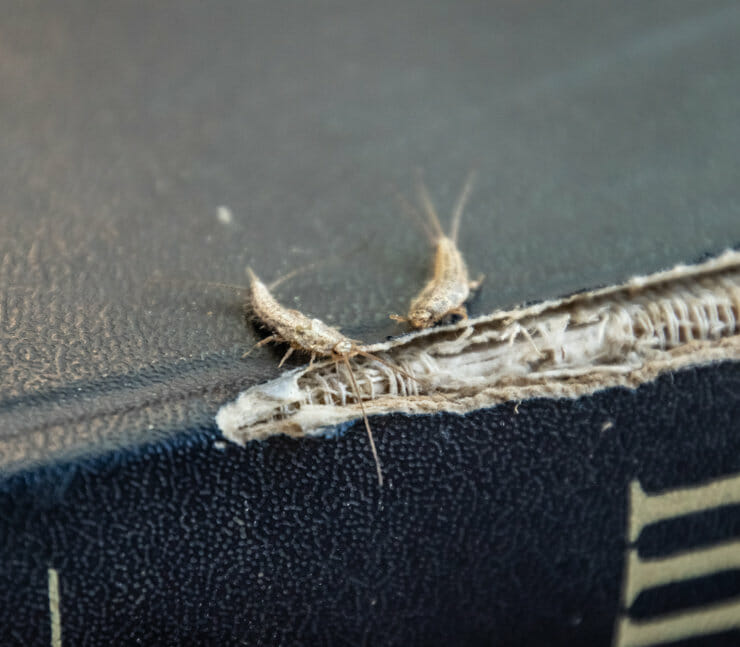Are you noticing odd, silvery insects crawling around at night?
What are these creepy-crawlies? And how did they get into your house?
There’s good news and bad news.
The bad news is that you probably have a silverfish infestation. The good news is that you don’t have to live with it forever.
Here at Smith’s Pest Management, our team addresses silverfish infestations in San Francisco Bay Area homes each day.
In this post, we’ll share our top tips on how to get rid of silverfish and keep your space bug-free for years to come.
Key Takeaways
- You can get rid of silverfish using homemade starchy traps, wet newspaper, sticky traps, cedar oil, dried bay leaves, borax, insecticides, or store-bought chemical traps.
- Silverfish are some of the most common pest insects in the world, and they can live as long as 8 years. Inside your home, silverfish can cause property damage by chewing holes in furniture, textiles, clothing, upholstery, wallpaper, and more.
- Silverfish are attracted to areas that offer ample food (they eat fibers, sugars, fabrics, grains, and dried goods), shelter, and water. They’re especially attracted to moisture and will appear anywhere where moisture levels are high.
- Discourage silverfish from returning by keeping your home clean, storing dry food in airtight containers, eliminating silverfish food sources, sealing small cracks around windows and doors, and improving the ventilation in your home.
How to Get Rid of Silverfish: 8 Effective Methods

Naturally With Home Remedies
1. Create your own silverfish traps
Silverfish love starchy foods, and they’ll go to great lengths to seek them out. To get rid of them, put some flour, dried cereal, or pet food in a glass container. Leave the top off and wrap the outside with tape.
Silverfish will be able to get into the jar by using the textured surface of the tape. They won’t be able to get back out, though, because their feet can’t get traction on the smooth glass surface inside.
Pros: Easy, affordable, safe for kids and pets, non-toxic
Cons: Unsightly, labor-intensive, requires you to dispose of dead silverfish
2. Use newspaper to attract them
Wet an old newspaper and roll it up. Silverfish will crawl into it and start making their homes. After a few days, throw the newspaper away in a sealed, airtight container. Alternatively, you can burn it to get rid of the silverfish that have found their way inside.
Pros: Affordable, safe, non-toxic, simple, effective
Cons: May not be applicable for households with kids (who may move the trap), will not eliminate large concentrations of silverfish
3. Put out sticky traps
Sticky traps, available at most hardware or home and garden stores, are an excellent way to get rid of silverfish. Purchase several of these traps and place them anywhere you’ve noticed silverfish activity. After a few days, check the traps and discard any that have silverfish stuck to them.
Pros: Easy, affordable, effective, safe, non-toxic
Cons: Not ideal for homes with kids or pets, unsightly, requires you to check and remove old traps
4. Use cedar oil
Cedar oil is one of the many essential oils used to get rid of silverfish, and is an especially effective pest killer for silverfish, clothes moths, and carpet beetles.
For best results, place cedar oil in a diffuser, or mix several drops of the oil into a spray bottle filled with warm water and spray the mixture onto problem areas.
If you’re using a diffuser, place it anywhere you’ve noticed silverfish activity.
Pros: Effective, affordable, safe
Cons: May bother people with sensitive skin or allergies, requires regular re-application
5. Use dried bay leaves
You don’t need to go any further than your pantry for an effective silverfish repellent. Just grab a few dried bay leaves and place them anywhere you’ve seen silverfish signs.
Silverfish are repelled by the oils in bay leaves, which have proven to be powerful pest deterrents.
Pros: Easy, affordable, effective
Cons: Will not kill pests, may be messy, requires regular re-application of bay leaves
6. Use borax
Borax is an effective way to kill silverfish. For best results, purchase borax at your local home goods store, and spread a thin layer anywhere you’ve noticed silverfish. It’s particularly appropriate for use on the back side of cabinets, along baseboards, in closets, and beneath appliances.
Alternatively, you can use diatomaceous earth for the same purpose.
Pros: Easy, affordable, effective
Cons: Messy, requires regular re-application, should be kept away from food, and should not be used near children or pets
With Conventional Methods
7. Insecticides
Insecticides are an effective method of silverfish control. Like all insects, silverfish can be managed through various chemical pest control methods. Foggers, bombs, and targeted sprays are all options for coping with a silverfish infestation.
Since these products are toxic and dangerous for kids, pets, and all other inhabitants of your household, though, we recommend limiting their use and ensuring you follow all label instructions carefully.
8. Chemical traps
Store-bought traps are an effective way to get rid of silverfish. Like other methods, these should be used with caution and should never be deployed in areas with kids or pets present.
How to Get Rid of Silverfish in Various Areas
In your apartment
If you have a severe silverfish infestation in your apartment, you’ll need to contact a licensed pest control service like Smith’s. Working within the context of a rental apartment can be difficult, and you don’t want to accidentally damage the property in the process or violate your rental agreement.
A professional pest management company will work with you and your landlord to provide a safe, effective service to solve your infestation problem.
In the bathroom cabinets
Since silverfish love moisture, they gravitate toward bathtubs and drains. The last thing you want to do, though, is bathe with these creepy-crawlies. To get rid of silverfish in these areas, the best option is to dehydrate the area and get rid of their hiding places.
Eliminate all clutter in the bathroom, including piled-up paper or towels, and give all the hidden corners of the room a good vacuum. Sprinkle diatomaceous earth in the corners of the room and add a dehumidifier to remove excess moisture from the room.
In your bed
Although silverfish prefer places like closets and bathrooms, it is possible to find them in your bed. If this happens, remove all bedding and wash it in hot water. Dry it on the highest possible setting (always check the fabric care label first to make sure this won’t damage the item).
The next step is to remove clutter from around your bedroom. If the infestation is severe and you live in the San Francisco Bay Area, contact Smith’s for professional pest control services in your bedroom.
In the attic or basement
The attic and basement are both hidden, quiet places for silverfish to live. If you notice them in these spaces, you’ll need to take an aggressive approach. In these spaces, boric acid is an excellent pest removal option.
Sprinkle it in the cracks and crevices throughout your basement, after you’ve vacuumed and swept up any dust and gotten rid of clutter. The same tactic applies to your attic.
In the closet
You don’t want to use poison in your closet. Instead, use a non-toxic repellent like cedar oil on the baseboards and seams of your closets. The aroma will prevent insects from attacking your clothing. Remember, a little goes a long way.
You don’t need to drench your clothing to keep silverfish away. In addition to applying the oil, be sure to vacuum the back and corners of your closet.
Outside your home or in windows
Spray the outside of your home with store-bought insect repellent, paying special attention to the line of your foundation, and the area around your windows and doors.
Remove clutter from around the outside of your home and cut back brush and foliage to at least 16” from your home.
How do Pest Control Experts Get Rid of Silverfish?

When you hire a silverfish pest control company like Smith’s, what can you expect?
Here’s the process our team uses to get rid of silverfish:
1. A thorough inspection
Our team always starts with a thorough inspection. One of our techs will inspect the indoor and outdoor areas of your home to identify areas of concentrated pest activity, and any access points they may be using to get into your home.
We’ll also evaluate environmental factors like landscaping, water sources, breeding habitats, and food sources the silverfish may be relying on.
2. Deployment of a customized plan
Based on what we find during our inspection, we’ll design a pest management plan to help reduce silverfish populations.
This pest management plan will include Integrated Pest Management (IPM) practices and techniques that focus both on eliminating the pests and resolving the underlying causes of the infestation.
3. Ongoing pest control monitoring
Once we’ve gotten rid of the initial silverfish infestation, we’ll provide ongoing pest control monitoring to keep them from coming back.
While we usually provide monthly or quarterly pest control services, we’ll determine the right frequency for you based on the nature of your property and the severity of your silverfish problem.
How to Prevent Silverfish

Regarding silverfish infestations, an ounce of prevention is worth a pound of cure. Use these tips to prevent future silverfish infestations on your property:
- Keep a clean home. A clean home helps prevent pests of all kinds. It also gives you an opportunity to inspect for signs of a new pest infestation, like droppings and skin molts. With this in mind, dust and vacuum your home at least once a week, or more frequently if you have kids or pets. Use a vacuum with a HEPA filter, which will suck up and contain silverfish eggs, so the bugs can’t continue to multiply.
- Seal all dry food and pet food in airtight containers. If you have food in boxes, like cereal, decant it into sealed, airtight containers. Store larger bags in big rubber tubs with tight-fitting lids. Clean up all food spills promptly.
- Get rid of silverfish food sources. Remember: silverfish eat both organic and non-organic materials. To keep them away, get rid of external food sources like piles of brush, dead plants, wood piles, and leaves. Keep the perimeter of your home clean and clear of leaves, shrubbery, or other moisture-rich debris. Inside, make sure to secure all food sources (as mentioned above) and get rid of clutter, such as piles of paper and cardboard boxes. Since silverfish are also attracted to items with adhesive, remove and destroy cardboard boxes, stacks of paper, and similar items.
- Keep your clothing in a dry place. Eliminate humidity in your home by storing your clothing in a cool, dry environment. Keep them out of the basement and install a dehumidifier if your home tends to be moist.
- Seal the cracks. Use caulk to seal small cracks around windows and doors and prevent access points that silverfish and other pests may be using to get into your home.
- Focus on ventilation. Remember – silverfish love moisture. To make your home as inhospitable as possible for them, focus on ventilating rooms that tend to stay warm and moist, like bathrooms. Open the windows and doors to promote airflow, and use vent fans to pull hot, moist air outside. You can also use a dehumidifier or a vent fan to keep things cool and dry.
Are Silverfish Invading Your San Francisco Bay Area Home or Business? We’re Here to Help!
Here at Smith’s Pest Management, we help residential and commercial properties from Northern California to Monterey get rid of pests, including silverfish as part of our pest control services.
If you have a silverfish infestation in your home, our team can help.
Contact us today to learn more about our services or book your silverfish treatment today.
FAQ
What are silverfish?

Silverfish are one of the most common pest insects in the world. They’re sometimes called bristletails or paper fish, even though their scientific name is Lepisma saccharinum.
Silverfish are voracious eaters who subsist on foods that are high in starches. They especially love paper, and will eat through boxes, books, and other household materials.
These insects are silver or gray in color, and their bodies are covered in tiny scales, which are often described as fish-like.
The body is broadest at the head, and tapers down to the posterior end, where there are three long appendages, each covered in bristles. One of the appendages runs straight out from the end of the body, while the other two jut out from the left and right sides of the torso at ninety-degree angles.
Silverfish are about 0.5”-1” in length and can live as long as eight years. The insects are nocturnal and are rarely seen during the daytime hours.
What attracts silverfish to my house?
If you have a silverfish infestation, you’re probably wondering where the bugs came from.
Here are the things that will attract silverfish to your house:
- Proper habitat. In their natural environments, silverfish live in moist, well-protected areas, like under logs and rocks, or in leaf litter. In a household environment, though, they tend to live behind furniture, in books, in basements, or near sinks. They need moisture to survive and will establish themselves anywhere moisture levels in your home are high.
- Food sources. Like all insects, silverfish need to eat. These bugs rely on starchy food sources like fibers, sugars, fabrics, grains, and dried goods – like cereals and pet food. Part of the reason that silverfish are so difficult to get rid of is that, in nature, they eat almost anything, from starches and carbohydrates to protein. In their natural environment, they eat composting plant material, leaves, and other decomposing items. In your home, they’ll happily munch on food scraps, stray pieces of pet food, and dried goods, like sugar, flour, and cereal.
- Places to lay eggs. Silverfish lay eggs in dark, moist, hidden areas of the home. The eggs are yellow or white, and bulb-shaped.
- A place to hide. Silverfish love to establish themselves in protected areas like behind furniture, in bookshelves, or in damp basements. While making your home inhospitable to silverfish will help get rid of them, you may need the help of a pest control specialist for severe infestations.
You might be wondering, “Do silverfish mean my house is dirty?” Contrary to popular myth, silverfish are not drawn to dirty homes.
Instead, silverfish love moisture, so their presence tends to indicate moisture rather than dirtiness in a home. Since silverfish eat common building and construction materials, even clean homes will offer them plenty of sustenance.
That said, silverfish see dusty areas of the home as a smorgasbord. Since dust is mostly made of organic residue, like human skin and dander, silverfish can usually survive on dust alone.
As silverfish in your home die off or become injured, the remaining living silverfish will eat the carcasses to fulfill their protein needs.
Are silverfish dangerous to people and pets?
Silverfish are not harmful to people. They do not bite, sting, or carry diseases or pathogens.
Even though they’re not a threat to your health, silverfish are not pests you want to live with.
Silverfish can damage household goods and building materials, and their creepy presence will quickly make your home an unpleasant place to be.
Additionally, some people with severe allergic symptoms may experience reactions (like itching, cough, and mucus buildup) to the feces or skin molts of silverfish.
People who are allergic to dust mites are usually also allergic to silverfish. Notably, the molted exoskeletons of silverfish contain a protein called tropomyosin, which can combine with other common allergens and generate a recombinant allergen, which can cause stronger allergic reactions.
What are the signs of a silverfish infestation?

Think you might have silverfish in your home? Here are five signs to look for:
- Seeing live silverfish. The first sign of silverfish infestation is the presence of live silverfish. These small, flexible, slippery insects range in color from blue-silver to brown-grey. They’re shaped like a teardrop and wiggle back and forth when they move, much like a fish does when swimming. Spotting silverfish is difficult since they are nocturnal, but seeing even a single live silverfish is a good indication that you have an infestation somewhere in the home.
- Droppings. Silverfish have fairly unique droppings. They look like small, black peppercorns, and are typically found in areas silverfish like to frequent, like the backs of furniture or the space beneath cupboards. Silverfish droppings are small enough that many people mistake them for dust or household debris. If you sweep once and they keep coming back, though, you’ll know you have a pest problem.
- Skin molts. Silverfish shed their skins throughout their lives. The outer shells are small, delicate, and transparent, but are a good indication of a silverfish infestation.
- Yellow stains on your belongings. Even if you don’t notice actual skin molts, you may see the yellow dust left behind on surfaces as silverfish molt. These yellow stains often show up in books, papers, cardboard boxes, or on clothing.
- Damage to belongings. One of the easiest ways to spot silverfish is to identify the damage they’re causing. Silverfish eat starchy food like wallpaper, linens, clothing, and cardboard. Look for holes chewed through items like these to confirm that you have a silverfish infestation.






